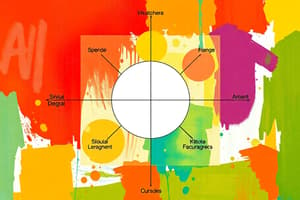Podcast
Questions and Answers
What is the first step in the A3 problem-solving process?
What is the first step in the A3 problem-solving process?
- Perform a root cause analysis (correct)
- Confirm your results
- Develop counter measures
- Complete follow-up actions
Which step involves reviewing the effectiveness of implemented measures?
Which step involves reviewing the effectiveness of implemented measures?
- Develop counter measures
- Confirm your results (correct)
- Complete follow-up actions
- Perform a root cause analysis
What should be done after identifying the root causes?
What should be done after identifying the root causes?
- Complete follow-up actions
- Confirm your results
- Develop counter measures (correct)
- Perform a root cause analysis
What is the purpose of follow-up actions in the A3 process?
What is the purpose of follow-up actions in the A3 process?
Which step requires drafting a detailed plan for deployment?
Which step requires drafting a detailed plan for deployment?
What must be determined during the confirmation of results?
What must be determined during the confirmation of results?
How many steps are outlined in the A3 problem-solving process?
How many steps are outlined in the A3 problem-solving process?
What is crucial to do before developing counter measures?
What is crucial to do before developing counter measures?
What is the primary philosophy behind Obeya?
What is the primary philosophy behind Obeya?
Which of the following is typically included in the 'big room' setting?
Which of the following is typically included in the 'big room' setting?
Conditions of Satisfaction (CoS) primarily ensure what aspect of a project?
Conditions of Satisfaction (CoS) primarily ensure what aspect of a project?
What is meant by conditions of satisfaction being 'measurable'?
What is meant by conditions of satisfaction being 'measurable'?
What is one of the key roles of team members in the big room?
What is one of the key roles of team members in the big room?
Which of the following best describes the purpose of inviting feedback in the big room?
Which of the following best describes the purpose of inviting feedback in the big room?
What is an important benefit of building a cohesive team environment in Obeya?
What is an important benefit of building a cohesive team environment in Obeya?
Which of the following statements about Conditions of Satisfaction is incorrect?
Which of the following statements about Conditions of Satisfaction is incorrect?
What is the primary purpose of the 'Do' stage in the Deming Cycle?
What is the primary purpose of the 'Do' stage in the Deming Cycle?
During which stage of the Deming Cycle is performance assessed against defined expectations?
During which stage of the Deming Cycle is performance assessed against defined expectations?
What should you do if the results of the study stage indicate that your solution was not successful?
What should you do if the results of the study stage indicate that your solution was not successful?
What is the final step of the Deming Cycle?
What is the final step of the Deming Cycle?
What is a key characteristic of the 'Plan' stage in the Deming Cycle?
What is a key characteristic of the 'Plan' stage in the Deming Cycle?
Which stage of the Deming Cycle directly follows the 'Do' stage?
Which stage of the Deming Cycle directly follows the 'Do' stage?
Which participant is identified as the Main Developer?
Which participant is identified as the Main Developer?
In the Deming Cycle, what is crucial to gather during the 'Do' stage?
In the Deming Cycle, what is crucial to gather during the 'Do' stage?
What is a key benefit of implementing Obeya in project management?
What is a key benefit of implementing Obeya in project management?
Who leads the Track Lighting Team?
Who leads the Track Lighting Team?
What is emphasized in the 'Act' stage of the Deming Cycle?
What is emphasized in the 'Act' stage of the Deming Cycle?
Which concept is essential to the successful application of Obeya?
Which concept is essential to the successful application of Obeya?
Which participant is associated with the Klarewell Development?
Which participant is associated with the Klarewell Development?
What role does Ernie Becklesten hold in the project?
What role does Ernie Becklesten hold in the project?
How does Lean philosophy influence Obeya implementation?
How does Lean philosophy influence Obeya implementation?
Which of the following is NOT a participant in the Obeya as mentioned?
Which of the following is NOT a participant in the Obeya as mentioned?
What does the 'Big Room' concept primarily focus on?
What does the 'Big Room' concept primarily focus on?
In what way can Obeya enhance program activities?
In what way can Obeya enhance program activities?
Who is responsible for the Pit Construction?
Who is responsible for the Pit Construction?
Which role is associated with the Track Designer?
Which role is associated with the Track Designer?
Which step focuses on the specifics of the problem and its impact on the business?
Which step focuses on the specifics of the problem and its impact on the business?
Which participant is not directly involved in a creative or technical role?
Which participant is not directly involved in a creative or technical role?
What should be included when making the business case for addressing a problem?
What should be included when making the business case for addressing a problem?
In which step of the A3 problem-solving process do you state the specific project improvement goals?
In which step of the A3 problem-solving process do you state the specific project improvement goals?
What is the main purpose of using visual depictions in a problem-solution context?
What is the main purpose of using visual depictions in a problem-solution context?
Which of the following steps comes immediately after defining the current condition?
Which of the following steps comes immediately after defining the current condition?
What should the focus be when describing the background of the problem?
What should the focus be when describing the background of the problem?
Which step does not directly involve analyzing the problem itself?
Which step does not directly involve analyzing the problem itself?
Flashcards
Obeya
Obeya
A collaborative, visual approach to project management that emphasizes transparency, communication, and team cohesiveness. It takes inspiration from Lean development principles.
Big Room
Big Room
A visual display of key project information, such as scope, milestones, plans, and progress. It also highlights problem-solving efforts and countermeasures.
Big Room Meeting
Big Room Meeting
A regularly scheduled meeting held in the Big Room where team members come together to review project progress, discuss challenges, and make decisions.
Conditions of Satisfaction (CoS)
Conditions of Satisfaction (CoS)
Signup and view all the flashcards
Co-Developing CoS
Co-Developing CoS
Signup and view all the flashcards
Measurable CoS
Measurable CoS
Signup and view all the flashcards
Promoting Feedback
Promoting Feedback
Signup and view all the flashcards
Demonstrating Accountability
Demonstrating Accountability
Signup and view all the flashcards
Plan
Plan
Signup and view all the flashcards
Act
Act
Signup and view all the flashcards
Do
Do
Signup and view all the flashcards
Study
Study
Signup and view all the flashcards
Do: Test the Solution
Do: Test the Solution
Signup and view all the flashcards
Do: Gather Data
Do: Gather Data
Signup and view all the flashcards
Study: Analyze Results
Study: Analyze Results
Signup and view all the flashcards
Study: Decision Point
Study: Decision Point
Signup and view all the flashcards
A3 Problem Template
A3 Problem Template
Signup and view all the flashcards
Describe the Background
Describe the Background
Signup and view all the flashcards
Define the Current State
Define the Current State
Signup and view all the flashcards
Agree on an Improvement Goal
Agree on an Improvement Goal
Signup and view all the flashcards
Analysis
Analysis
Signup and view all the flashcards
Proposal
Proposal
Signup and view all the flashcards
Plan/Impact
Plan/Impact
Signup and view all the flashcards
Follow-Up
Follow-Up
Signup and view all the flashcards
What is Obeya?
What is Obeya?
Signup and view all the flashcards
What is Lean philosophy?
What is Lean philosophy?
Signup and view all the flashcards
What is commitment-based management?
What is commitment-based management?
Signup and view all the flashcards
What are Conditions of Satisfaction (CoS)?
What are Conditions of Satisfaction (CoS)?
Signup and view all the flashcards
How does continuous improvement impact Obeya?
How does continuous improvement impact Obeya?
Signup and view all the flashcards
A3 Problem-Solving Process
A3 Problem-Solving Process
Signup and view all the flashcards
Define the problem
Define the problem
Signup and view all the flashcards
Root Cause Analysis
Root Cause Analysis
Signup and view all the flashcards
Develop Countermeasures
Develop Countermeasures
Signup and view all the flashcards
Implement Countermeasures
Implement Countermeasures
Signup and view all the flashcards
Confirm Results
Confirm Results
Signup and view all the flashcards
Complete Follow-up Actions
Complete Follow-up Actions
Signup and view all the flashcards
Document and Share Learnings
Document and Share Learnings
Signup and view all the flashcards
What are Big Room Meetings used for?
What are Big Room Meetings used for?
Signup and view all the flashcards
What is Co-Developing CoS?
What is Co-Developing CoS?
Signup and view all the flashcards
What does it mean for CoS to be Measurable?
What does it mean for CoS to be Measurable?
Signup and view all the flashcards
How does Obeya promote feedback?
How does Obeya promote feedback?
Signup and view all the flashcards
How does Obeya demonstrate accountability?
How does Obeya demonstrate accountability?
Signup and view all the flashcards
Who should participate in an Obeya?
Who should participate in an Obeya?
Signup and view all the flashcards
Study Notes
Obeya (The Big Room)
- Obeya is a unique approach to running projects or programs.
- It is derived from the Japanese word for "big room".
- It provides dedicated time and space for coordination and problem-solving.
- It minimizes organizational barriers.
- Obeya is a process of engagement and transparency with an emphasis on mindset and behavior.
- Obeya is also a physical space where technical experts gather to track progress and priorities.
Objectives
- The importance of lean philosophy and its impact on Obeya implementation are key.
- How to apply the continuous improvement mindset is essential.
- The principal mechanics of the big room are crucial.
- How to use Obeya to enhance program activities is a key objective.
What is Obeya?
- Obeya is derived from the Japanese word for "big room".
- It is a unique approach to project or program running.
- Obeya provides a dedicated time and space for coordination and problem-solving.
- It aims to minimize organizational barriers.
More than Just a Big Room
- Obeya is a process of engagement and transparency with an emphasis on mindset and behavior.
- It is a physical space where technical experts gather.
- Project progress and priorities are visually tracked.
- Project information is posted on the walls.
Why is Obeya Necessary?
- Effective big rooms support cross-functional team collaboration.
- They advance project work and bring teams involved in a project up to speed on the activities of other groups or individuals.
The Philosophy Behind Obeya
- The overarching philosophy of Obeya comes from Lean development.
- It promotes collaborative project running.
- Obeya leverages effective communication.
- It fosters a cohesive team environment.
What's in the Big Room?
- The big room contains visually appealing information such as scope milestones, plans, and progress to date.
- It also includes problem-solving and countermeasures for technical or scheduling issues.
Participating in the Big Room
- Participation is a scheduled and recurring event.
- Members can invite feedback, demonstrate accountability, make decisions, and schedule events.
- Comparing the current project state to published goals or conditions of satisfaction (CoS) is essential.
Conditions of Satisfaction
- Conditions of Satisfaction (CoS) are an explicit description of requirements for customer satisfaction.
- These requirements are explicit descriptions of all requirements that must be met for a customer to feel they've received what they wanted.
- CoS contains agreed-upon priorities for the project.
- The CoS can be a key element used to ensure all stakeholders are satisfied.
- Each condition of satisfaction is a commitment, with all team members responsible for delivery.
- CoS must be measurable.
Conditions of Satisfaction: Examples
- Typically, 8 to 15 conditions of satisfaction are established.
- These conditions often address budget, schedule, and safety objectives and so on.
- Possible examples include profitability for everyone, months until project delivery, numbers of requests for information (RFIs), changes, punch-list items, percentage below market costs, and operational cost improvement.
- Percentage improvement in productivity, rapid improvement and exceptional teamwork are quality metrics.
- All schedules must be developed and executed using a Last Planner® system.
All Conditions of Satisfaction Must Be Met
- Conditions of satisfaction should not be ranked or ordered.
- All conditions of satisfaction must be met.
- This promotes a new way of thinking and working.
Case Study: Temecula Valley Hospital
- The hospital met in their big room two days a week.
- Teams collaborated to solve problems before working in silos, and reported back on accomplishments.
- They determined the direction of the project together.
Implementing Obeya for Your Built Environment Project
- Obeya must be more than just a tool or physical space.
- Key principles need to be understood and lived to realize its true potential.
Big Room Rules
- Includes preparation, improvement, effective onboarding, positive reinforcement, focus on learning, safe/confidential zone, no stripes, speak up, and listen to others.
Signs Your Obeya May Be Failing
- Signs of failure include everything appearing green, lack of identified problems or agreed/resolved actions, and lack of understanding.
- Information might not be updated and the space could be only used for meetings, with disengaged or distracted people.
Management by Exception
- Management by exception provides a different approach.
- Moving from command and control to managing by exception.
- Allows project teams to save time, run more efficiently, and deal with necessary tasks.
- Controls problem areas to improve approach, priorities and timelines.
Other Benefits of Obeya
- Acts as an accelerator for cohesion, building traction, and moving the project towards goals.
- Obeya encourages leadership effectiveness.
- It promotes a high degree of transparency, leading to greater collaboration, better problem-solving, and faster decisions.
Setting Up a Big Room
- Big room focus is collaboration.
- This leads to high levels of cooperation.
The Physical Space
- A large open room with breakout spaces and rooms is essential.
- Sufficient technology for team activities is required.
- A file-sharing structure and bio considerations should be accounted for.
- Visual elements are necessary.
Big Room Approaches
- Colocated: Participants are continuously located together.
- Recurring: Participants meet regularly, but may not be colocated.
- Hybrid: Combines in-person and virtual attendance.
- Virtual: Participants are in different locations and time zones. Additional technology considerations for each approach include smart boards, video conferencing, file- and information-sharing, flip charts, markers, sticky notes, and whiteboards.
Return and Report
- Return and report procedures are essential.
- Ensure reporting backs on accomplishments and progress.
Solving Problems within Obeya
- Essential approach.
Continuous Improvement: The Deming Cycle
- The Deming Cycle includes Plan, Do, Study, and Act.
- Each is a key part of Obeya to continually refine projects.
- Crucial for continuous improvement.
The Deming Cycle: Plan, Do, Study, Act
- Plan: Define a problem or opportunity, generate ideas, and build an implementation plan—establishing performance success criteria and making them measurable.
- Do: Test a potential solution, and monitor processes and results to gain insights.
- Study: Analyze the results of the pilot project, and check performance against defined expectations/criteria.
- Act: Implement the solution and make it standard practice.
Walk Me Through a Hypothetical Example
- Facilitating communication between Helmut Schmidt, the track designer, and Cody Bielbaugh of the safety barrier company is needed.
- A good idea for the Deming cycle to illustrate this process (e.g., problem recognition, idea generation, testing, analysis, and implementation) is needed.
A3 Problem-Solving
- A3 problem-solving is a collaborative approach.
- It promotes exchanging information, ideas and perspectives.
- Provides a consistent and common approach.
- Summarizes a project on a single sheet of paper.
- Is a visual representation of data and information.
A3 Problem-Solving Uses the Whole Brain
- A3 problem-solving brings together the right and left brain, including visual and analysis/reasoning.
- It promotes a systems-thinking approach, which considers how actions impact other parts of a project.
A3 Problem Template
- Breakdown into common sequential steps: background, current state, goal/objective, analysis, proposal, plan/impact, and follow-up.
A3 Problem-Solving Steps
- The process has seven steps: describe the background, make the business case, state the problem impact details, define the current condition, agree on an improvement project goal, perform a root cause analysis, develop counter-measures, confirm results, and complete follow up actions.
Who Should Participate
- Determining relevant project personnel.
- Clear rationale to justify involvement in Obeya meetings.
What Did You Decide
- The outcome of the Obeya meeting.
- Participants' decisions and conclusions.
Monisha Klarewill, Carson Rachelsen, Francesco Gehri & Wright Francis, Edison Lumos, Helmut Schmidt, Ernie Becklesten, Tyrell Chapman, and Cody Bielbaugh
- Project personnel roles and responsibilities within the project outlined.
Studying That Suits You
Use AI to generate personalized quizzes and flashcards to suit your learning preferences.




